The Intersection of Technology and Law: Unpacking the Implications of AI Legislation
Artificial Intelligence technology is on the rise, with its applications spreading across various sectors of society. As the capabilities of AI continue to advance, the need for proper legal frameworks guiding its use becomes increasingly critical. This article delves into this complex and fascinating topic, exploring the historical context, current legal updates, and societal implications of AI legislation.

The Emergence of AI and the Law
Artificial Intelligence (AI) is not a new concept. It dates back to the mid-20th century when the field of AI research was formally founded at a conference at Dartmouth College in 1956. However, it is only in the past few decades that AI has moved from being a theoretical concept to a practical tool with profound implications for various sectors of society, including law.
While AI has brought about numerous benefits, its rapid development has also raised complex legal questions. As AI systems become increasingly sophisticated, they begin to challenge traditional legal concepts and frameworks, necessitating the development of new legal paradigms to guide their use.
Recent Developments in AI Legislation
In recent years, several jurisdictions have made attempts to address the legal challenges posed by AI. For instance, the European Union recently proposed the Artificial Intelligence Act, a comprehensive framework that aims to regulate AI systems and protect fundamental rights.
The Act classifies AI systems into different risk categories, each subject to specific requirements and restrictions. It also includes provisions to promote transparency and accountability in AI systems, ensuring that they are used responsibly and ethically.
Societal Implications of AI Legislation
The implications of AI legislation are vast, affecting various aspects of society. On the one hand, appropriate regulation can help prevent misuse of AI systems and protect individual rights. For instance, regulating facial recognition technology can help prevent unwarranted surveillance and protect privacy rights.
On the other hand, overly restrictive regulation can stifle innovation and hinder the development of beneficial AI applications. Striking the right balance is a complex task that requires careful consideration of various factors, including technological advancements, societal values, and legal principles.
Navigating the Future of AI Legislation
There is still much work to be done in the area of AI legislation. As AI continues to evolve, so too must the laws that govern its use. This requires ongoing dialogue and cooperation among various stakeholders, including policymakers, technologists, legal experts, and the public.
One of the main challenges in this regard is the inherent uncertainty of AI technology. Given the rapid pace of technological advancement, it is difficult to predict with certainty how AI will evolve and what implications this will have for society.
Conclusion
The intersection of technology and law is a complex and fascinating area of study. As AI continues to evolve, it challenges traditional legal frameworks and necessitates the development of new legal paradigms. While the task is complex, it is also an exciting opportunity to shape the future of technology and society.
By staying informed about the latest developments in AI legislation and engaging in thoughtful dialogue about its implications, we can all play a role in shaping the future of this transformative technology.




